More evacuations near Indian factory after fatal gas leak
By OMER FAROOQ today

Smoke rises from LG Polymers plant, the site of a chemical gas leakage, in Vishakhapatnam, India, Thursday, May 7, 2020. Synthetic chemical styrene leaked from the industrial plant in southern India early Thursday, leaving people struggling to breathe and collapsing in the streets as they tried to flee. Administrator Vinay Chand said several people fainted on the road and were rushed to a hospital. (AP Photo)
HYDERABAD, India (AP) — Indian authorities evacuated more people from villages near a South Korean-owned chemical factory where a gas leak killed 12 people and left about 1,000 struggling to breathe.
Authorities said the evacuation was precautionary, but it triggered panic among people overnight that another gas leak was occurring.
“No, there was not another leakage,” National Disaster Response Force spokesman Krishan Kumar said Friday.
Factory owner LG Chem said it asked police to evacuate residents because of concerns that rising temperatures at the plant’s gas tank could possibly cause another leak. The company said it was injecting water into the tank and applying other measures to keep temperatures under control.
A state administrator in the district, Vinay Chand, said authorities flew in chemicals from a neighboring state to neutralize the gas completely before allowing people to return to their homes.

A National Disaster Response Force (NDRF) soldier is fitted with gear before he proceeds to the area from where chemical gas leaked in Vishakhapatnam, India, Thursday, May 7, 2020. Chemical gas leaked from an industrial plant in southern India early Thursday, leaving people struggling to breathe and collapsing in the streets as they tried to flee. Administrator Vinay Chand said several people fainted on the road and were rushed to a hospital. (AP Photo)
Expert teams were checking the factory’s vicinity for any aftereffects of the gas leak. Residents of five villages are waiting for a clear signal to return to their homes, Chand said.
The initial evacuations on Thursday affected about 3,000 people.
The death toll rose to 12 on Friday with one person dying in a hospital, P.V. Sudhakar, a doctor, said.
Chand said 316 people were being treated in hospitals and were in stable condition. State police chief Damodar Gautam Sawang said 800 people were released after treatment on Thursday.
The chemical styrene, used to make plastic and rubber, on Thursday leaked from the LG Polymers plant on the outskirts of the eastern coastal city of Vishakhapatnam in Andhra Pradesh state while workers were preparing to restart the facility after a coronavirus lockdown was eased.
The leak was suspected to have come from large tanks left unattended over the past six weeks.
“Our initial information is that workers were checking a gas storage tank when it started leaking,” said Industries Minister M. Goutham Reddy.

People pour water on a hatchling affected by a chemical gas leak in Vishakhapatnam, India, Thursday, May 7, 2020. Chemical gas leaked from an industrial plant in southern India early Thursday, leaving people struggling to breathe and collapsing in the streets as they tried to flee. Administrator Vinay Chand said several people fainted on the road and were rushed to a hospital. (AP Photo)
Videos and photos from the area showed dozens of people lying unconscious in the streets, arms open wide with white froth trailing from their mouths. People fled on foot, on motorbikes and in open trucks as police officers, some wearing gas masks, rushed to get people out of their homes.
The scene evoked bitter memories of the Bhopal industrial disaster in 1984 that killed at least 4,000 people and injured another 500,000, many of them with chronic health problems today, according to the government.
The blanket of gas spread about 3 kilometers (1.8 miles), sickening people in at least four villages. The leak was stopped by 8 a.m. Thursday, officials said.
A neurotoxin, styrene gas can immobilize a person within minutes of inhalation and be deadly at high concentrations.
LG Chem Ltd. is South Korea’s largest chemical company and produces a range of industrial products, including petrochemicals, plastic and batteries used in electronic vehicles. It is part of the family-owned LG Corp. conglomerate, which also has an electronics arm that globally sells smartphones, TVs and personal computers.
South Korea’s Foreign Ministry said Friday its ambassador to India had expressed regrets and condolences over the gas leak. A ministry statement said the South Korean government is closely monitoring efforts to handle the aftermath.

Firefighters walk with oxygen cylinders outside LG Polymers plant, the site of a chemical gas leak, in Vishakhapatnam, India, Thursday, May 7, 2020. Synthetic chemical styrene leaked from the industrial plant in southern India early Thursday, leaving people struggling to breathe and collapsing in the streets as they tried to flee. Administrator Vinay Chand said several people fainted on the road and were rushed to a hospital. (AP Photo)
LG Chem began operating the plant in Vishakhapatnam in 1997 and its Indian operation is one of the leading manufacturers of polystyrene and expandable polystyrene in the country. The Vishakhapatnam plant has around 300 workers.
The bowl-shaped coastal city in Andhra Pradesh state is an industrial hub known for frequent gas leak accidents. In December 2019, a leak from a pharmaceutical company killed two people.
“We have not learnt from our past mistakes,” said E.A.S. Sarma, a former senior state official, referring to the 1984 Bhopal gas leak.
Considered the world’s worst industrial accident, the leak of methyl isocyanate at a Union Carbide India pesticide plant prompted successive Indian governments to pledge to improve safety standards. But many similar accidents, although on a smaller scale, continue.

People affected by a chemical gas leak are carried out of a truck to an ambulance in Vishakhapatnam, India, Thursday, May 7, 2020. Chemical gas leaked from an industrial plant in southern India early Thursday, leaving people struggling to breathe and collapsing in the streets as they tried to flee. Administrator Vinay Chand said several people fainted on the road and were rushed to a hospital. (AP Photo)
Toxic gas leak at Indian chemical plant kills at least 11 and hospitalizes hundreds
By Vedika Sud, Akanksha Sharma, Jessie Yeung, Esha Mitra and Emma Reynolds,
At least 11 people have been confirmed dead and hundreds more have been hospitalized after the incident at an LG Polymers plant, which lies near a village of at least 3,000 people on the outskirts of the city of Visakhapatnam.
Most of the dead were driving or standing on terraces outside their homes when they lost consciousness and fell where they stood, while others slipped into unconsciousness while they were sleeping, said Mekapati Goutham Reddy, minister for Industries, Commerce, and Information Technology in Andhra Pradesh. Three of those who died were children, he added.
Almost 1,000 people were directly exposed to the gas and about 20-25 people are in critical but stable condition, said Kamal Kishore from the National Disaster Management Authority.
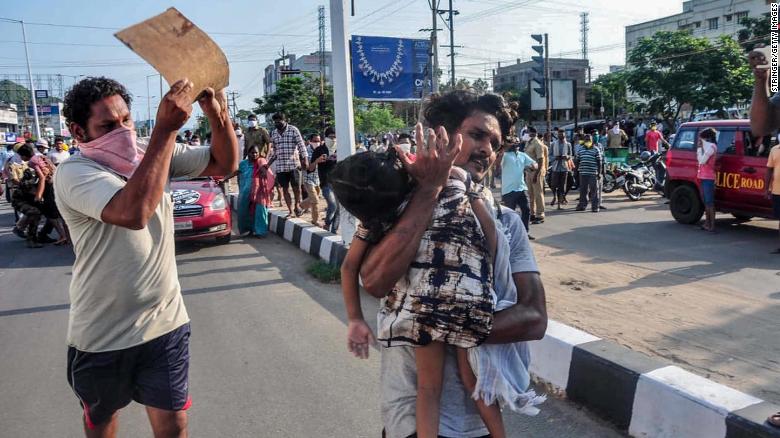
A man runs from the toxic gas leak carrying an unconscious child as 5,000 people were evacuated from the area.
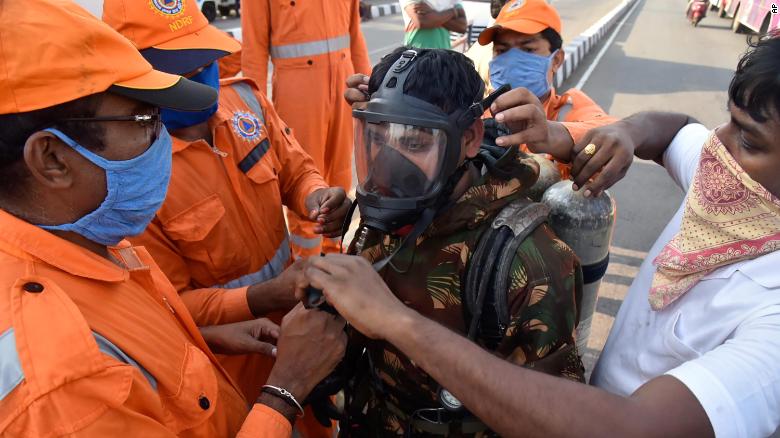
A member of India's National Disaster Response Force (NDRF) is fitted with protective gear before he enters the area affected by the leak.
The gas has been identified as Styrene, a flammable liquid that is used to make a variety of industrial products, including polystyrene, fiberglass, rubber, and latex.
"When we arrived on the spot a lot of people were lying on the ground unconscious and we evacuated around 1,000 people and rushed them to the hospital," said Tej Bharath, a senior Vishakhapatnam district official.
Gopalapatnam Police helped hundreds of people to escape the apocalyptic scenes in ambulances, police vehicles, and state-provided buses, while others left on their own, said local police Inspector V Ramanayya.
At least 285 people are now in hospital, said K Kanna Babu, managing director of the state's disaster response force. Individuals were taken to hospitals across the city to be treated for exposure of the gas.
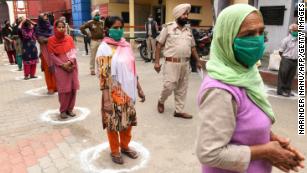
How does India, a country of 1.3 billion people, have around 1,000 coronavirus deaths?
Babu said the district administration received the call by around 3:30 a.m. and his team was notified around 5:30 a.m. and were on-field by 6 a.m. But, he added, "we couldn't immediately enter because the smell of the gas was very pungent so we had to wait for half an hour before we could go in and start evacuating people."
The gas came out the factory's chimney and was carried by the wind, he said.
There are 10,000 people within the affected area of the gas leak; about 5,000 have been evacuated.
Photos tweeted by Satya Pradhan, director general of the NDRF, showed team members in hazmat suits and gas masks helping residents to safety.
Disaster response teams have brought the leakage in the silo to a minimum and it is almost under control, authorities confirmed in a press briefing.
"Overall the situation is under control. Now, the situation is of rehab and treatment," said Pradhan.
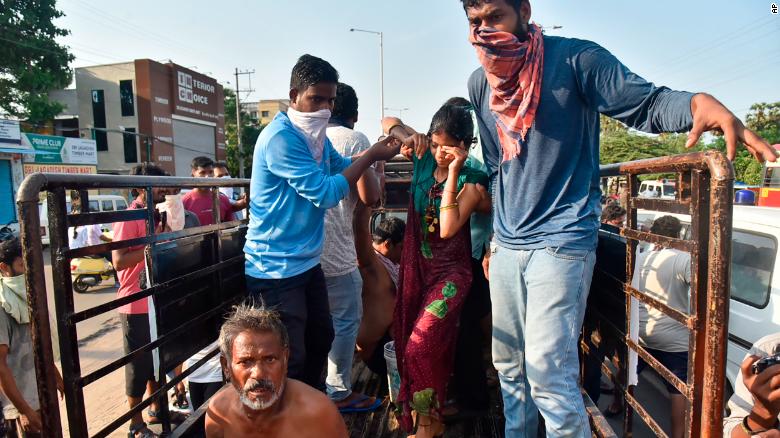
People affected by the gas leak are carried out of a truck to an ambulance in Vishakhapatnam.
How it happened
It is not immediately clear what led to the leak. However, the plant, which is owned by the South Korean company LG Chem, was preparing to reopen after coronavirus lockdown restrictions were eased, with the gas leak occurring during the process of re-starting operations, according to Bharath, the Visakhapatnam district official.
Reddy, the Andhra Pradesh minister, said workers at the plant had been conducting regular maintenance and gauging whether it was ready to return to full production. It was during this process that they found the leak coming from a storage tank, where the chemical had turned into a gas.
They immediately worked to neutralize the chemical, and had shut down the plant within an hour, Reddy said.
But Reddy said an alarm should have been raised when the gas leaked and asked why that didn't happen.
An LG Chem communications official told CNN that the plant's alarm only detects if raw Styrene is leaked in liquid form, and "something in there reacted," which meant it "leaked in vapor form."
Asked why it had turned into vapor, the official added: "That is something we need to investigate."
In a statement to CNN, LG Chem said it was taking measures to protect residents affected by the leak.
"(We) are currently assessing local town residents' damage situation and are taking maximum necessary measures for the protection of residents and employees together with related organizations," said the statement.
"The factory's gas leak is currently under control. Leaked gas can cause vomiting and dizziness from inhaling. (We) are seeking all measures so that related treatment can be done quickly."
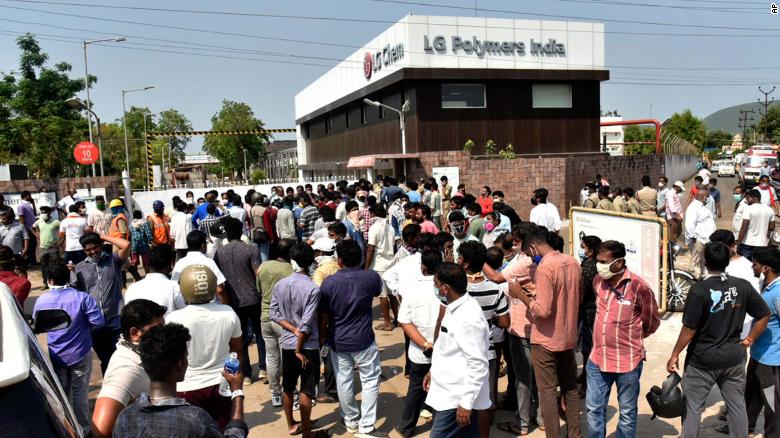
A crowd gathers outside the plant after the leak.
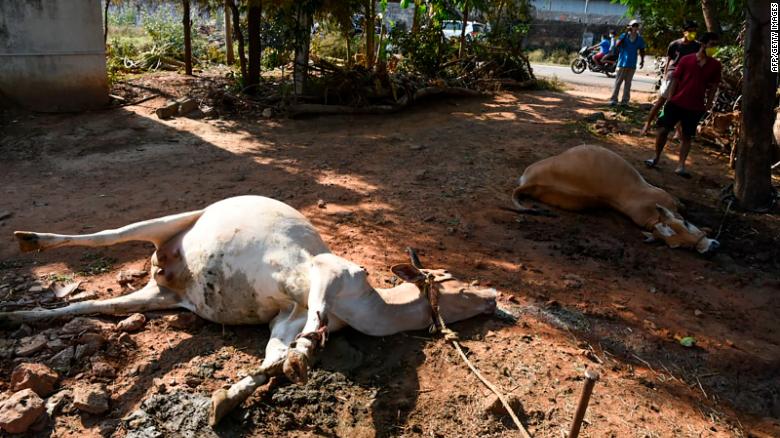
Dead cows on the ground after the leak at an LG Polymers plant, which had recently reopened after the coronavirus lockdown.
"There is no specific antidote to reverse the effect of Styrene. The treatment does remain mainly supportive. Individuals have to be removed from the exposed area," said Dr. Randeep Guleria, Director at the All India Institute of Medical Sciences.
Local police are investigating the cause of the leak and conducting house to house visits in adjoining areas.
Photos of the aftermath has drawn parallels online with the Bhopal disaster -- a gas leak in the central Indian city of Bhopal in December 1984.
Nearly half a million people were exposed to toxic fumes, nearly 4,000 people died in the immediate aftermath, and around 10,000 subsequent deaths have been blamed on the leak, which is now considered one of the world's worst industrial disasters.
This leak is likely not as lethal as the Bhopal disaster, said Reddy, the state minister.
Government response
Indian Prime Minister Narendra Modi said in a tweet today that he had spoken with officials regarding Thursday's leak, and was monitoring the situation.
"I pray for everyone's safety and well-being in Visakhapatnam," he tweeted.
The state's chief minister is also set to visit the city hospital where residents are being treated, his office confirmed in a tweet.
"The Chief Minister is closely monitoring the situation and has directed the district officials to take every possible step to save lives and bring the situation under control," said the tweet.
The city's civic authority, the Greater Visakhapatnam Municipal Corporation (GVMC), warned residents to stay indoors during the response effort.
"There is gas leakage identified at LG Polymers in Gopalpatnam. Requesting Citizens around these locations not to come out of houses for the sake of safety precautions," GVMC tweeted. "As precautionary measures, the colonies and villages around the industry may leave to safer locations. Please use wet cloth as mask to cover nose and mouth."
Now as efforts turn from evacuation and rescue to investigation, state officials are beginning to look into the cause of the leak.
"Right now we are not taking any action but certainly the burden of proof lies with them (LG) -- to come forward and say what they have done," said Reddy. "We need to understand to what extent was this negligence or what it was. It will all come subsequently once we start ascertaining the situation on the ground."
He said that compensation of $131,000 per family will be given to those who have lost a loved one. LG will be asked to pay what it can and the state government will cover the rest, he added.
This story has been corrected to reflect that the plant has not yet reopened.
CNN's Swati Gupta contributed to this report.
Battle to prevent fresh gas leak at Indian plant

By OMER FAROOQ today

Smoke rises from LG Polymers plant, the site of a chemical gas leakage, in Vishakhapatnam, India, Thursday, May 7, 2020. Synthetic chemical styrene leaked from the industrial plant in southern India early Thursday, leaving people struggling to breathe and collapsing in the streets as they tried to flee. Administrator Vinay Chand said several people fainted on the road and were rushed to a hospital. (AP Photo)
HYDERABAD, India (AP) — Indian authorities evacuated more people from villages near a South Korean-owned chemical factory where a gas leak killed 12 people and left about 1,000 struggling to breathe.
Authorities said the evacuation was precautionary, but it triggered panic among people overnight that another gas leak was occurring.
“No, there was not another leakage,” National Disaster Response Force spokesman Krishan Kumar said Friday.
Factory owner LG Chem said it asked police to evacuate residents because of concerns that rising temperatures at the plant’s gas tank could possibly cause another leak. The company said it was injecting water into the tank and applying other measures to keep temperatures under control.
A state administrator in the district, Vinay Chand, said authorities flew in chemicals from a neighboring state to neutralize the gas completely before allowing people to return to their homes.

A National Disaster Response Force (NDRF) soldier is fitted with gear before he proceeds to the area from where chemical gas leaked in Vishakhapatnam, India, Thursday, May 7, 2020. Chemical gas leaked from an industrial plant in southern India early Thursday, leaving people struggling to breathe and collapsing in the streets as they tried to flee. Administrator Vinay Chand said several people fainted on the road and were rushed to a hospital. (AP Photo)
Expert teams were checking the factory’s vicinity for any aftereffects of the gas leak. Residents of five villages are waiting for a clear signal to return to their homes, Chand said.
The initial evacuations on Thursday affected about 3,000 people.
The death toll rose to 12 on Friday with one person dying in a hospital, P.V. Sudhakar, a doctor, said.
Chand said 316 people were being treated in hospitals and were in stable condition. State police chief Damodar Gautam Sawang said 800 people were released after treatment on Thursday.
The chemical styrene, used to make plastic and rubber, on Thursday leaked from the LG Polymers plant on the outskirts of the eastern coastal city of Vishakhapatnam in Andhra Pradesh state while workers were preparing to restart the facility after a coronavirus lockdown was eased.
The leak was suspected to have come from large tanks left unattended over the past six weeks.
“Our initial information is that workers were checking a gas storage tank when it started leaking,” said Industries Minister M. Goutham Reddy.

People pour water on a hatchling affected by a chemical gas leak in Vishakhapatnam, India, Thursday, May 7, 2020. Chemical gas leaked from an industrial plant in southern India early Thursday, leaving people struggling to breathe and collapsing in the streets as they tried to flee. Administrator Vinay Chand said several people fainted on the road and were rushed to a hospital. (AP Photo)
Videos and photos from the area showed dozens of people lying unconscious in the streets, arms open wide with white froth trailing from their mouths. People fled on foot, on motorbikes and in open trucks as police officers, some wearing gas masks, rushed to get people out of their homes.
The scene evoked bitter memories of the Bhopal industrial disaster in 1984 that killed at least 4,000 people and injured another 500,000, many of them with chronic health problems today, according to the government.
The blanket of gas spread about 3 kilometers (1.8 miles), sickening people in at least four villages. The leak was stopped by 8 a.m. Thursday, officials said.
A neurotoxin, styrene gas can immobilize a person within minutes of inhalation and be deadly at high concentrations.
LG Chem Ltd. is South Korea’s largest chemical company and produces a range of industrial products, including petrochemicals, plastic and batteries used in electronic vehicles. It is part of the family-owned LG Corp. conglomerate, which also has an electronics arm that globally sells smartphones, TVs and personal computers.
South Korea’s Foreign Ministry said Friday its ambassador to India had expressed regrets and condolences over the gas leak. A ministry statement said the South Korean government is closely monitoring efforts to handle the aftermath.

Firefighters walk with oxygen cylinders outside LG Polymers plant, the site of a chemical gas leak, in Vishakhapatnam, India, Thursday, May 7, 2020. Synthetic chemical styrene leaked from the industrial plant in southern India early Thursday, leaving people struggling to breathe and collapsing in the streets as they tried to flee. Administrator Vinay Chand said several people fainted on the road and were rushed to a hospital. (AP Photo)
LG Chem began operating the plant in Vishakhapatnam in 1997 and its Indian operation is one of the leading manufacturers of polystyrene and expandable polystyrene in the country. The Vishakhapatnam plant has around 300 workers.
The bowl-shaped coastal city in Andhra Pradesh state is an industrial hub known for frequent gas leak accidents. In December 2019, a leak from a pharmaceutical company killed two people.
“We have not learnt from our past mistakes,” said E.A.S. Sarma, a former senior state official, referring to the 1984 Bhopal gas leak.
Considered the world’s worst industrial accident, the leak of methyl isocyanate at a Union Carbide India pesticide plant prompted successive Indian governments to pledge to improve safety standards. But many similar accidents, although on a smaller scale, continue.

People affected by a chemical gas leak are carried out of a truck to an ambulance in Vishakhapatnam, India, Thursday, May 7, 2020. Chemical gas leaked from an industrial plant in southern India early Thursday, leaving people struggling to breathe and collapsing in the streets as they tried to flee. Administrator Vinay Chand said several people fainted on the road and were rushed to a hospital. (AP Photo)
Toxic gas leak at Indian chemical plant kills at least 11 and hospitalizes hundreds
By Vedika Sud, Akanksha Sharma, Jessie Yeung, Esha Mitra and Emma Reynolds,
CNN Thu May 7, 2020
(CNN)Bodies lay crumpled on the ground beside toppled motorcycles and cars as suffocating toxic gas rose from a chemical plant in southern India in the early hours of Thursday morning.
Roads near the site of the fatal leak in the state of Andhra Pradesh were filled with hundreds of people fleeing the noxious gas, according to footage from the scene, many carrying the injured and unconscious over their shoulders.
Rescuers from India's National Disaster Response Force (NDRF) wearing hazmat suits and gas masks were also seen running with limp bodies in their arms.
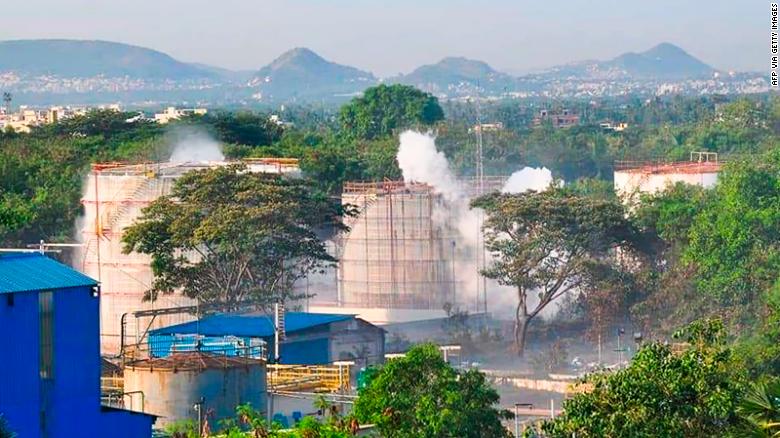
Smoke rises from the chemical plant after the leak.
(CNN)Bodies lay crumpled on the ground beside toppled motorcycles and cars as suffocating toxic gas rose from a chemical plant in southern India in the early hours of Thursday morning.
Roads near the site of the fatal leak in the state of Andhra Pradesh were filled with hundreds of people fleeing the noxious gas, according to footage from the scene, many carrying the injured and unconscious over their shoulders.
Rescuers from India's National Disaster Response Force (NDRF) wearing hazmat suits and gas masks were also seen running with limp bodies in their arms.

Smoke rises from the chemical plant after the leak.
At least 11 people have been confirmed dead and hundreds more have been hospitalized after the incident at an LG Polymers plant, which lies near a village of at least 3,000 people on the outskirts of the city of Visakhapatnam.
Most of the dead were driving or standing on terraces outside their homes when they lost consciousness and fell where they stood, while others slipped into unconsciousness while they were sleeping, said Mekapati Goutham Reddy, minister for Industries, Commerce, and Information Technology in Andhra Pradesh. Three of those who died were children, he added.
Almost 1,000 people were directly exposed to the gas and about 20-25 people are in critical but stable condition, said Kamal Kishore from the National Disaster Management Authority.

A man runs from the toxic gas leak carrying an unconscious child as 5,000 people were evacuated from the area.

A member of India's National Disaster Response Force (NDRF) is fitted with protective gear before he enters the area affected by the leak.
The gas has been identified as Styrene, a flammable liquid that is used to make a variety of industrial products, including polystyrene, fiberglass, rubber, and latex.
"When we arrived on the spot a lot of people were lying on the ground unconscious and we evacuated around 1,000 people and rushed them to the hospital," said Tej Bharath, a senior Vishakhapatnam district official.
Gopalapatnam Police helped hundreds of people to escape the apocalyptic scenes in ambulances, police vehicles, and state-provided buses, while others left on their own, said local police Inspector V Ramanayya.
At least 285 people are now in hospital, said K Kanna Babu, managing director of the state's disaster response force. Individuals were taken to hospitals across the city to be treated for exposure of the gas.

How does India, a country of 1.3 billion people, have around 1,000 coronavirus deaths?
Babu said the district administration received the call by around 3:30 a.m. and his team was notified around 5:30 a.m. and were on-field by 6 a.m. But, he added, "we couldn't immediately enter because the smell of the gas was very pungent so we had to wait for half an hour before we could go in and start evacuating people."
The gas came out the factory's chimney and was carried by the wind, he said.
There are 10,000 people within the affected area of the gas leak; about 5,000 have been evacuated.
Photos tweeted by Satya Pradhan, director general of the NDRF, showed team members in hazmat suits and gas masks helping residents to safety.
Disaster response teams have brought the leakage in the silo to a minimum and it is almost under control, authorities confirmed in a press briefing.
"Overall the situation is under control. Now, the situation is of rehab and treatment," said Pradhan.

People affected by the gas leak are carried out of a truck to an ambulance in Vishakhapatnam.
How it happened
It is not immediately clear what led to the leak. However, the plant, which is owned by the South Korean company LG Chem, was preparing to reopen after coronavirus lockdown restrictions were eased, with the gas leak occurring during the process of re-starting operations, according to Bharath, the Visakhapatnam district official.
Reddy, the Andhra Pradesh minister, said workers at the plant had been conducting regular maintenance and gauging whether it was ready to return to full production. It was during this process that they found the leak coming from a storage tank, where the chemical had turned into a gas.
They immediately worked to neutralize the chemical, and had shut down the plant within an hour, Reddy said.
But Reddy said an alarm should have been raised when the gas leaked and asked why that didn't happen.
An LG Chem communications official told CNN that the plant's alarm only detects if raw Styrene is leaked in liquid form, and "something in there reacted," which meant it "leaked in vapor form."
Asked why it had turned into vapor, the official added: "That is something we need to investigate."
In a statement to CNN, LG Chem said it was taking measures to protect residents affected by the leak.
"(We) are currently assessing local town residents' damage situation and are taking maximum necessary measures for the protection of residents and employees together with related organizations," said the statement.
"The factory's gas leak is currently under control. Leaked gas can cause vomiting and dizziness from inhaling. (We) are seeking all measures so that related treatment can be done quickly."

A crowd gathers outside the plant after the leak.

Dead cows on the ground after the leak at an LG Polymers plant, which had recently reopened after the coronavirus lockdown.
"There is no specific antidote to reverse the effect of Styrene. The treatment does remain mainly supportive. Individuals have to be removed from the exposed area," said Dr. Randeep Guleria, Director at the All India Institute of Medical Sciences.
Local police are investigating the cause of the leak and conducting house to house visits in adjoining areas.
Photos of the aftermath has drawn parallels online with the Bhopal disaster -- a gas leak in the central Indian city of Bhopal in December 1984.
Nearly half a million people were exposed to toxic fumes, nearly 4,000 people died in the immediate aftermath, and around 10,000 subsequent deaths have been blamed on the leak, which is now considered one of the world's worst industrial disasters.
This leak is likely not as lethal as the Bhopal disaster, said Reddy, the state minister.
Government response
Indian Prime Minister Narendra Modi said in a tweet today that he had spoken with officials regarding Thursday's leak, and was monitoring the situation.
"I pray for everyone's safety and well-being in Visakhapatnam," he tweeted.
The state's chief minister is also set to visit the city hospital where residents are being treated, his office confirmed in a tweet.
"The Chief Minister is closely monitoring the situation and has directed the district officials to take every possible step to save lives and bring the situation under control," said the tweet.
The city's civic authority, the Greater Visakhapatnam Municipal Corporation (GVMC), warned residents to stay indoors during the response effort.
"There is gas leakage identified at LG Polymers in Gopalpatnam. Requesting Citizens around these locations not to come out of houses for the sake of safety precautions," GVMC tweeted. "As precautionary measures, the colonies and villages around the industry may leave to safer locations. Please use wet cloth as mask to cover nose and mouth."
Now as efforts turn from evacuation and rescue to investigation, state officials are beginning to look into the cause of the leak.
"Right now we are not taking any action but certainly the burden of proof lies with them (LG) -- to come forward and say what they have done," said Reddy. "We need to understand to what extent was this negligence or what it was. It will all come subsequently once we start ascertaining the situation on the ground."
He said that compensation of $131,000 per family will be given to those who have lost a loved one. LG will be asked to pay what it can and the state government will cover the rest, he added.
This story has been corrected to reflect that the plant has not yet reopened.
CNN's Swati Gupta contributed to this report.
Battle to prevent fresh gas leak at Indian plant

AFP / -A gas leak at the LG Polymers plant killed 12 people and knocked others unconscious in the street
Engineers battled Friday to prevent more toxic gas escaping at a chemical plant on India's east coast, a day after a pre-dawn leak killed 12 people and knocked locals unconscious in the street.
Although the death toll was lower than feared, the accident which left hundreds hospitalised outside the industrial port city of Visakhapatnam evoked memories of Bhopal where a gas leak killed around 3,500 people in 1984.
Late on Thursday the evacuation zone around the plant owned by South Korea's LG Chem was widened with hundreds more people in 10 localities brought to safety as a precaution, police said.
"The situation is better now but we can't say it is completely normal. The temperature in the tanks has been brought down by 120 degrees but we need to being it down further by 25 degrees," senior police officer Swaroop Rani told AFP.

Engineers battled Friday to prevent more toxic gas escaping at a chemical plant on India's east coast, a day after a pre-dawn leak killed 12 people and knocked locals unconscious in the street.
Although the death toll was lower than feared, the accident which left hundreds hospitalised outside the industrial port city of Visakhapatnam evoked memories of Bhopal where a gas leak killed around 3,500 people in 1984.
Late on Thursday the evacuation zone around the plant owned by South Korea's LG Chem was widened with hundreds more people in 10 localities brought to safety as a precaution, police said.
"The situation is better now but we can't say it is completely normal. The temperature in the tanks has been brought down by 120 degrees but we need to being it down further by 25 degrees," senior police officer Swaroop Rani told AFP.

AFP / Gal ROMAGas leak at Indian chemical plant
"Twelve people have died so far. No one is critical. But we have told those who have recovered that they may go either to their relatives' houses or to shelters that we have set up till the situation is completely normal," she said.
Plant owner LG Chem said Friday there was no fresh leak, but as a precautionary measure nearby people should be moved.
The company "made a request to the police to evacuate residents in case of an emergency if the temperature rises in the tank", it said in a statement issued in Seoul.
"Currently, we are taking necessary measures, such as adding water into the tank" to keep it cool.

"Twelve people have died so far. No one is critical. But we have told those who have recovered that they may go either to their relatives' houses or to shelters that we have set up till the situation is completely normal," she said.
Plant owner LG Chem said Friday there was no fresh leak, but as a precautionary measure nearby people should be moved.
The company "made a request to the police to evacuate residents in case of an emergency if the temperature rises in the tank", it said in a statement issued in Seoul.
"Currently, we are taking necessary measures, such as adding water into the tank" to keep it cool.

AFP / -Rescuers evacuate people following the gas leak in Visakhapatnam. Engineers were working to prevent more gas escaping from the chemical plant
Horrifying footage on Indian television showed men, women and children slumped motionless in the streets after the Thursday morning gas escape.
"There was utter confusion and panic. People were unable to breathe, they were gasping for air. Those who were trying to escape collapsed on the roads -- kids, women and all," local resident Kumar Reddy, 24, told reporters.
B K Naik, district hospitals coordinator, said 1,000 had initially been hospitalised. By Thursday afternoon around 600 remained in treatment, with none in a critical condition.
"This is a calamity," Naik told AFP.
AFP photographs taken at the King George Hospital in the city early Thursday had shown two or three patients on each bed, some of them children, and several unconscious.
- Prayers -
"I pray for everyone's safety and well-being in Visakhapatnam," Prime Minister Narendra Modi said on Twitter.
The plant, operated by LG Polymers, a subsidiary of LG Chem, is on the outskirts of Visakhapatnam.

Horrifying footage on Indian television showed men, women and children slumped motionless in the streets after the Thursday morning gas escape.
"There was utter confusion and panic. People were unable to breathe, they were gasping for air. Those who were trying to escape collapsed on the roads -- kids, women and all," local resident Kumar Reddy, 24, told reporters.
B K Naik, district hospitals coordinator, said 1,000 had initially been hospitalised. By Thursday afternoon around 600 remained in treatment, with none in a critical condition.
"This is a calamity," Naik told AFP.
AFP photographs taken at the King George Hospital in the city early Thursday had shown two or three patients on each bed, some of them children, and several unconscious.
- Prayers -
"I pray for everyone's safety and well-being in Visakhapatnam," Prime Minister Narendra Modi said on Twitter.
The plant, operated by LG Polymers, a subsidiary of LG Chem, is on the outskirts of Visakhapatnam.

AFP / STRAround 1,000 people were taken to hospital after the gas leak
The city and the surrounding area are home to around five million people.
The plant had been left idle because of the coronavirus lockdown, according to Rani, an assistant police commissioner in Visakhapatnam.
"(The gas) was left there because of the lockdown. It led to a chemical reaction and heat was produced inside the tanks, and the gas leaked because of that," Rani told AFP on Thursday.
LG Chem confirmed the plant, which makes polystyrene products, was not operating because of the lockdown, but there were maintenance staff at the facility, a spokesman in Seoul told AFP.
- 'Ticking bombs' -
Authorities advised people to wear wet clothes and masks, avoid eating uncovered food and consume bananas and milk to "neutralise the effect of the gas".
According to the Centre for Science and Environment (CSE), the gas was styrene, which is likely carcinogenic and combined with oxygen in the air forms the more lethal styrene dioxide.
The leak happened because the gas was not stored at the appropriate temperature, causing pressure to build up and breaking the valve, the CSE said.
The tank was also "old and not properly maintained" and there was no monitoring mechanism installed to specifically detect styrene, it said.
The incident "shows us that there are ticking bombs out there as the lockdown ends and industries start resuming activities," it add
SEE UPDATES
https://plawiuk.blogspot.com/2020/05/update-indians-recall-horrifying.html
https://plawiuk.blogspot.com/2020/05/update-more-evacuations-near-indian.html
The city and the surrounding area are home to around five million people.
The plant had been left idle because of the coronavirus lockdown, according to Rani, an assistant police commissioner in Visakhapatnam.
"(The gas) was left there because of the lockdown. It led to a chemical reaction and heat was produced inside the tanks, and the gas leaked because of that," Rani told AFP on Thursday.
LG Chem confirmed the plant, which makes polystyrene products, was not operating because of the lockdown, but there were maintenance staff at the facility, a spokesman in Seoul told AFP.
- 'Ticking bombs' -
Authorities advised people to wear wet clothes and masks, avoid eating uncovered food and consume bananas and milk to "neutralise the effect of the gas".
According to the Centre for Science and Environment (CSE), the gas was styrene, which is likely carcinogenic and combined with oxygen in the air forms the more lethal styrene dioxide.
The leak happened because the gas was not stored at the appropriate temperature, causing pressure to build up and breaking the valve, the CSE said.
The tank was also "old and not properly maintained" and there was no monitoring mechanism installed to specifically detect styrene, it said.
The incident "shows us that there are ticking bombs out there as the lockdown ends and industries start resuming activities," it add
SEE UPDATES
https://plawiuk.blogspot.com/2020/05/update-indians-recall-horrifying.html
https://plawiuk.blogspot.com/2020/05/update-more-evacuations-near-indian.html
No comments:
Post a Comment